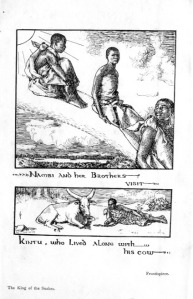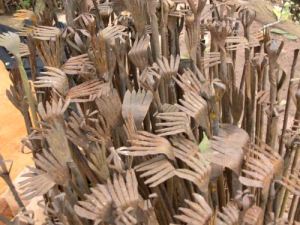Long long ago, Kintu was the only person on Earth. He lived alone with his cow, which he tended lovingly. Ggulu, the creator of all things, lived up in heaven with his many children and other property. From time to time, Ggulu’s children would come down to earth to play. On one such occasion, Ggulu’s daughter Nambi and some of her brothers encountered Kintu who was with his cow in Buganda. Nambi was very fascinated by Kintu, and she felt pity for him because he was living alone. She resolved to marry him and stay with him despite the opposition from her brothers. But because of her brothers’ pleading, she decided to return to heaven with Kintu and ask for her father’s permission for the union.
Ggulu was not pleased that his daughter wanted to get married to a human being and live with him on Earth. But Nambi pleaded with her father until she persuaded him to bless the union. After Ggulu had decided to allow the marriage to proceed, he advised Kintu and Nambi to leave heaven secretly. He advised them to pack lightly, and that on no condition were they to return to heaven even if they forgot anything. This admonition was so that Walumbe, one of Nambi’s brothers, should not find out about the marriage until they had left, otherwise he would insist on going with them and bring them misery (Walumbe means that which causes sickness and death). Kintu was very pleased to have been given a wife, and together they followed Ggulu’s instructions. Among the few things that Nambi packed was her chicken.
They set out for earth early the next morning. But while they were descending, Nambi remembered that she had forgotten to bring the millet to feed her chicken. “I have left my chickens’ millet on the porch, let me return and fetch it,” she begged Kintu. But Kintu refused and said, “Don’t go back. If you do, you will meet Walumbe and he will surely insist on coming with you.” Nambi, however, did not listen to her husband, and leaving him on the way she returned to fetch the millet. When she reached the house, she took the millet from the porch, but on her way back she suddenly met Walumbe who asked: “My sister, where are you going so early in the morning?” Nambi did not know what to say.
Filled with curiosity, Walumbe insisted on going with her. Therefore Kintu and Nambi were forced to go to Earth together with Walumbe. It did not take long for Kintu and Nambi to get children. One day, Walumbe went to Kintu’s home and asked his brother-in-law to give him a child to help him with the chores in his (Walumbe’s) house. But remembering Ggulu’s warning, Kintu would not hear of it. Walumbe became very angry with Kintu for refusing him the simple favour he had asked. That very night, he went and killed Kintu’s son. Naturally, this caused a deep rift between them. Kintu went back to heaven to report Walumbe’s actions to Ggulu.
Ggulu rebuked Kintu, reminding him of the original warning he had disregarded. Kintu blamed Nambi for returning to get the millet. Ggulu then sent another of his sons, Kayikuuzi, to go back to earth with Kintu and try to persuade Walumbe to return to heaven or, if necessary, return him by force. On reaching Earth, Kayikuuzi tried to persuade Walumbe to go back to heaven but Walumbe would not hear of it. “I like it here on Earth and I am not coming back with you”, he said. Kayikuuzi decided to capture Walumbe by force, and a great fight broke out between them. But as Walumbe was about to be overpowered, he escaped and disappeared into the ground. Kayikuuzi went after him, digging huge holes in the ground to try to find his brother. When Kayikuuzi got to where he was hiding, Walumbe run back out to the earth. Further struggle between the brothers ensued but once again Walumbe escaped into the ground.
The famous caves that are found today at Ttanda in Ssingo are said to be the ones that were dug by Kayikuuzi in the fight with his brother Walumbe. (Kayikuuzi means he who digs holes). The struggle went on for several days and by now, Kayikuuzi was close to exhaustion. So he went and talked to Kintu and Nambi as follows: “I am going back into the ground one more time to get Walumbe. You and your children must stay indoors. You must strictly command your children not to make a sound if they see Walumbe. I know he is also getting tired so when he comes out of the ground, I will come upon him secretly and grab him.” Kintu and Nambi went into their house, but some of the kids did not go in.
Kayikuuzi once again went underground to find Walumbe. After a struggle, Walumbe came back out to the surface with Kayikuuzi in pursuit. Kintu’s children who were outside at the time saw Walumbe coming and screamed in terror. On hearing the screams, Walumbe went underground once again. Kayikuuzi was furious with Kintu and Nambi for not having followed his instructions. He told them that if they did not care to do the simple thing he had asked of them, he was also giving up the fight. Kintu in his embarrassment had nothing more to say. So he told Kayikuuzi “You return to heaven. If Walumbe wants to kill my children, let him do so, I will keep having more. The more he kills, the more I will get and he will never be able to kill all my children”. Ttanda, where the fight between Walumbe and Kayikuuzi allegedly took place, is figuratively referred to as the place of death (i.e. Walumbe’s place).
So that is the legend of creation according to the Baganda, and how sickness and death started. Nonetheless, Kintu’s descendants will always exsist as Kintu said in his last words to Kayikuuzi. Hence the Kiganda saying “Abaana ba Kintu tebalifa kuggwaawo“. Which means that Kintu’s children (i.e. the Baganda) will never be wiped off the face of the earth.
We organize Cultural Tours to the mentioned places above for a real feel of this part of history!



This is interesting, these stories are no more in schools. Am glad to read this, i will always visit you guys.